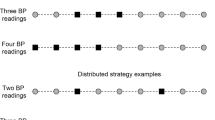Abstract
To test if an arbitrary definition of day and night periods that differs to patient-reported awake and sleep periods leads to inaccuracies in interpretation of ambulatory blood pressure monitoring (ABPM). A single-center, retrospective review was performed comparing three different methods to classify day and night periods following a single 24-h ABPM: method A: Patient's record during monitoring; method B: 7:00 am to 11:00 pm day and 11:00 pm to 7:00 am night; method C: 8:00 am to 8:00 pm day and midnight to 6:00 am night. We included 149 studies in 149 children with a mean ± SD age of 13.0 ± 3.4 years. Reported sleep duration was 9.2 ± 1.3 h. Significant differences resulted between three methods for the means of several ambulatory BP parameters including indexed BP values during day, BP load, and nocturnal dipping status. During monitoring [median (range)], 7.5% (0.0–27.5%) readings were misclassified using method B and 0.0% (0.0–20.0%) using method C (p < 0.0001). This misclassification resulted in change of hypertension status for 11.4% (17/149) patients using method B and 9.4% (14/149) patients using method C (p = 0.70). Misclassification of measurements during ABPM can introduce significant errors in its interpretation. The clinical impact of these findings needs further evaluation in larger prospective studies.


Similar content being viewed by others
References
Dolan E, Stanton A, Thijs L, Hinedi K, Atkins N, McClory S, Den Hond E, McCormack P, Staessen JA, O’Brien E (2005) Superiority of ambulatory over clinic blood pressure measurement in predicting mortality the Dublin outcome study. Hypertension 46:156–161
Ohkubo T, Hozawa A, Nagai K, Kikuya M, Tsuji I, Ito S, Satoh H, Hisamichi S, Imai Y (2000) Prediction of stroke by mortality by ambulatory blood pressure monitoring versus screening blood pressure measurements in a general population: the Ohasama study. J Hypertens 18:847–854
Clement DL, De Buyzere M, De Bacquer DA, de Leeuw PW, Duprez DA, Fagard RH, Gheeraert PJ, Missault LH, Braun JJ, Six RO, Van Der Niepen P, O’Brien E (2003) For the Office versus Ambulatory Blood Pressure (OvA) Study Investigators. Prognostic value of ambulatory blood pressure recordings in patients with treated hypertension. N Engl J Med 348:207–215
Filhi AJP, Mansoor GA, White WB (1995) Effects of actual versus arbitrary awake and sleep times on analyses of 24-h blood pressure. Am J Hypertens 8:676–680
Eissa MA, Yetman RJ, Poffenbarger T, Portman RJ (1999) Comparison of arbitrary definitions of circadian time periods with those determined by wrist actigraphy in analysis of ABPM data. J Hum Hypertens 13(11):759–763
Eissa MA, Poffenbarger T, Portman RJ (2001) Comparison of the actigraph versus patients' diary information in defining circadian time periods for analyzing ambulatory blood pressure monitoring data. Blood Press Monit 6(1):21–25
Iglowstein I, Jenni OG, Molinari L, Largo RH (2003) Sleep duration from infancy to adolescence: reference values and generational trends. Pediatrics 111(2):302–307
Wuhl E, Witte K, Soergel M, Mehls O, Schaefer F (2002) For the German Working Group on Pediatric Hypertension. Distribution of 24-h ambulatory blood pressure in children: normalized reference values and role of body dimensions. J Hypertens 20:1995–2007
Soergel M, Kirschstein M, Busch C, Danne T, Gellermann J, Holl R, Krull F, Reichert H, Reusz GS, Rascher W (1997) Oscillometric twenty-four-hour ambulatory blood pressure values in healthy children and adolescents: a multicenter trial including 1141 subjects. J Pediatr 130(2):178–184
Seeman T, Palyzova D, Jusek D, Janda J (2005) Reduced nocturnal blood pressure dip and sustained nighttime hypertension are specific markers of secondary hypertension. J Pediatr 147:366–371
Flynn JT (2002) Differentiation between primary and secondary hypertension in children using ambulatory blood pressure monitoring. Pediatrics 10(1):89–93
Stergiou GS, Alamara CV, Kalkana CB, Vaindirlis IN, Stefanidis CJ, Dacou-Voutetakis C, Mountokalakis TD (2004) Out-of-office blood pressure in children and adolescents: disparate findings by using home or ambulatory monitoring. Am J Hypertens 17:869–875
Lurbe E, Redon J, Kesani A, Pascual JM, Tacons J, Alvarez V, Batlle D (2002) Increase in nocturnal blood pressure and progression to microalbuminuria in type 1 diabetes. N Engl J Med 347(11):797–805
National High Blood Pressure Education Program Working Group on High Blood Pressure in Children and Adolescents (2004) The fourth report on the diagnosis, evaluation and treatment of high blood pressure in children and adolescents. Pediatrics 114:555–576
Sorof JM, Poffenbarger T, Franco K, Portman R (2001) Evaluation of white coat hypertension in children: importance of definitions of normal ambulatory blood pressure and the severity of hypertension. Am J Hypertens 14:855–860
Mitsnefes MM, Kimball TR, Witt SA, Glascock BJ, Khoury PR, Daniels SR (2004) Abnormal carotid artery structure and function in children and adolescents with successful renal transplantation. Circulation 110:97–101
Stabouli S, Kotsis V, Rizos Z, Toumanidis S, Karagianni C, Constantopoulos A, Zakopoulos N (2009) Left ventricular mass in normotensive, prehypertensive and hypertensive children and adolescents. Pediatr Nephrol 24:1545–1551
Patzer L, Seeman T, Luck C, Wühl E, Janda J, Misselwitz J (2003) Day- and night-time blood pressure elevation in children with higher grades of renal scarring. J Pediatr 142(2):117–122
Mitsnefes MM, Kimball TR, Daniels SR (2003) Office and ambulatory blood pressure elevation in children with chronic renal disease. Pediatr Nephrol 18:145–149
Acknowledgements
This manuscript was presented in part as an abstract at the Annual Meeting of the European Society of Pediatric Nephrology in 2008 at Lyon, France. MDS acknowledges financial support from the Department of Health via the National Institute for Health Research (NIHR) comprehensive Biomedical Research Centre award to Guy's & St Thomas' NHS Foundation Trust in partnership with King's College London and King’s College Hospital NHS Foundation Trust.
Sources of support or funding
None.
Conflict or interest or disclaimers
None.
Author information
Authors and Affiliations
Corresponding author
Rights and permissions
About this article
Cite this article
Jones, H.E., Sinha, M.D. The definition of daytime and nighttime influences the interpretation of ABPM in children. Pediatr Nephrol 26, 775–781 (2011). https://doi.org/10.1007/s00467-011-1791-3
Received:
Revised:
Accepted:
Published:
Issue Date:
DOI: https://doi.org/10.1007/s00467-011-1791-3




